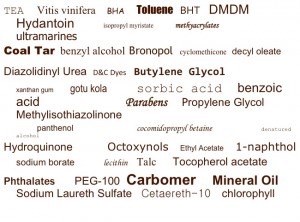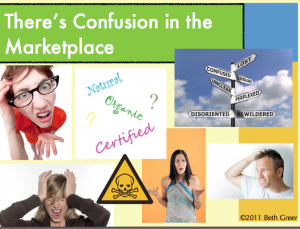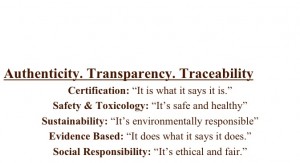Next week, a few thousand spa/wellness experts will convene at the Mandalay Bay for the annual ISPA conference. An expo floor of product suppliers will host a marketplace catering to spa directors, owners, and consultants. This begs the question: Do the buyers know what they want and how to go about looking for it? Do they understand the significance of their choices?
The Wellness Industry is a 2 Trillion dollar business. There are 289 million ‘wellness’ consumers in the world’s 30 most industrialized wealthiest countries. 76 million of that reside in the US and comprise 25% of the adult population. The $250 billion global beauty market is forecasted to grow by 12% by 2014. Baby care, skincare, sun care and men’s grooming are expected to drive future growth globally.*
At this fall’s Green Spa Network Congress, one afternoon was dedicated to helping eliminate confusion in evaluating and selecting personal care products. With all the ‘greenwashing’ claims, even the most seasoned spa director can be led astray. And unlike drugs, the FDA doesn’t review cosmetic/personal care ingredients for safety before they hit the market. In fact, personal care products and make-up often contain toxic chemicals linked to cancer, infertility, hormone imbalances, birth defects, neurological issues and other health problems.
Beth Greer, author of Super Natural Home, shared her personal health crisis that prompted her to re-evaluate her lifestyle and environment, identifying and eliminating toxins that she never suspected she was being exposed to. She shared some hard facts: 98% of more than 23K skincare and cosmetic products on the market contain ONE or MORE ingredients never evaluated for safety by FDA. The average consumer uses 15-25 products/day. WHAT WE PUT ON OUR SKIN MATTERS… OUR SKIN IS NOT A BARRIER.
Universal Companies Sustainability Specialist Lisa Sykes charges us, the spa industry, with the responsibility of being models for conscious living. “Personal care products are part of the detox process,” per Sykes. “In addition to nourishing the skin, they should enhance the spa atmosphere for relaxation, balance, and clarity. Personal care companies have the responsibility to support wellness centers/spas in their endeavor to provide cleansing and conscious living.” Her advice to us: Ask Questions; Analyze Marketing Messages; Check for Consistency; Do your Research.
But how do you do that if you don’t know what to look for?
Beauty expert & author Rona Berg shared some HOT & NOT SO HOT examples:
Hot General Categories with Green Examples:
• Skin brighteners/dark spots: licorice extract (glycyrrhizinate), Indian gooseberry, soy proteins, white algae, kojic acid
• Skin tighteners: rice bran oil-beauty secret inJapan, rich in antioxidants (and squalene), shown to promote collagen production
• Skin boosters + serums: with rosehip, jojoba, argan oils penetrate deeply
• Acids: still hot: glycolics, lactics, salicylics, AHAs (downside: thinning skin)
• Antibacterials: honey
• Antioxidants: vitamins A, C, D, E; pomegranate, resveratrol, acai and trans-resveratrol
• Anti-inflammatories: licorice extract, chamomile, green tea, borage oil, shea butter, vitamin K, pineapple (active: bromelain), pomegranate, probiotics: emerging data indicates that these protective bacteria may be beneficial for common skin problems such as redness, flaking, and inflammation
Not So Hot Ingredients
• Phthalates: Landmark Korean study last year linked phthalates to ADHD in 8-11 year olds. Researchers at Mount Sinai School of Medicine recently found babies born to mothers exposed while pregnant 2.5 times more likely to develop attention and behavior problems. Many products with “fragrance” or “perfume” contain phthalates—but not all.
• Hydroquinone: A skin-lightening agent now banned in many countries. Can cause serious skin irritation, swelling, and thick skin; may be carcinogenic.
• Talc: Related to asbestos. in powder formulations, particles are easily inhaled and may lead to tumors in lungs and ovaries.
Ingredients aren’t the only ones we need to look out for. The personal care and beauty products industry accounts for approximately a third of all landfill waste. 40% of women surveyed indicated that eco-packing was part of their decision when buying make up. As a result, P&G and Estee Lauder, two companies that own 28 brands between then, are switching to 100% renewable energy, eliminating the use of nonrenewable resource + petro-derived plastic as well as reducing the packaging size. We can consider more earth-friendly options like recyclable packaging, screen printing and soy inks, bamboo, and FSC certification (verifies products from the forest of origin thru the supply chain).
Finally, take the time to study the claims. Supernatural Home author Beth Greer shares her Top 10 Greenwashing Watchwords:
1. Made with… – could mean made with as little as 1% or 1 drop
2. Organic – many brands say ‘organic’ but contain few or no organic ingredients
3. Natural – can give give the illusion the product is “of nature” when it’s not
4. Certified Green – by whom?
5. Free of… – it may claim to have no parabens but substitutes Phenoxethanol
6. Derived from – some byproducts require use of carcinogenic synthetic chemical for extraction
7. Nontoxic – by whose standards? Toxicity threshold for The Consumer Product Safety Commission is lower than that of CA
8. Allergy-Friendly Fragrance, Fragrance-Free – may still contain artificial coloring or fragrances used to cover up the chemical smell of other ingredients
9. Dermatologist Tested, Sensitivity Tested, Hypoallergenic – Look for the organization behind these claims other than the company making the product
10. Environmentally Friendly, Eco-safe – The US Federal Trade Commission considers these phrases to be too vague to be meaningful to consumers.
*Spas & Global Wellness Market Survey, GSS/SRI International
*Euromonitor, a global marketing research firm




Kim Collier Says:
November 5th, 2011 at 2:27 amVisit Kim Collier
Excellent article, well written information, and important resources. Thank you Rianna, and looking forward to your lecture at ISPA next week ~ all the best!
Jessica Blaisdell Says:
November 8th, 2011 at 5:35 amVisit Jessica Blaisdell
Very informative. It is not pushing people what product to pick. The suggestions are making us think twice before we decide what to buy. Thank you for the information. A good reference for the concern public.
Janice Summers Says:
November 8th, 2011 at 8:44 pmVisit Janice Summers
Great article! I was sad I could not make it to the conference this year but glad to get this shared information.